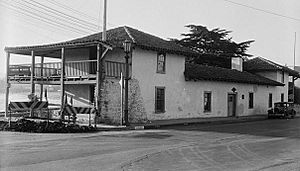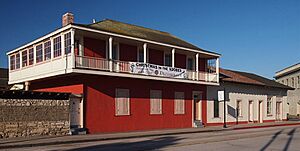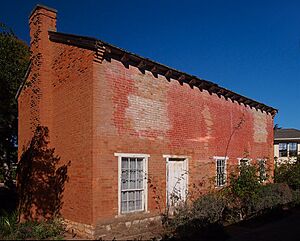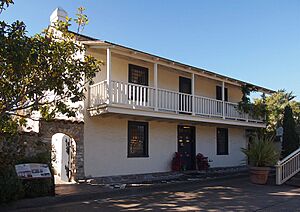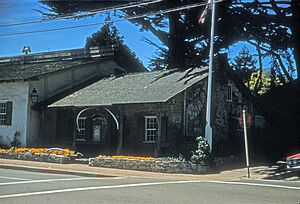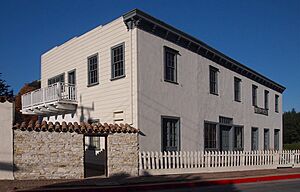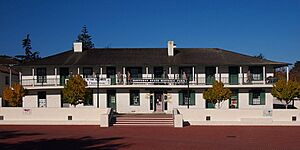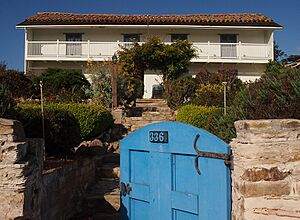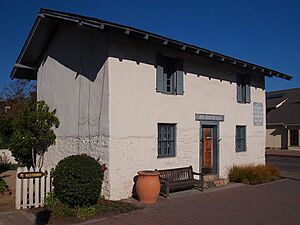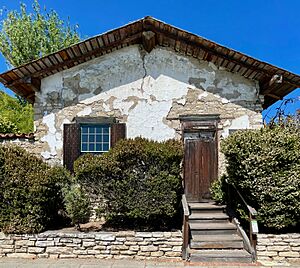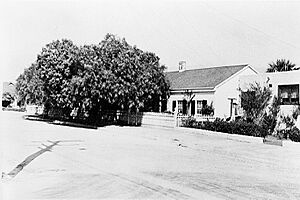Monterey State Historic Park facts for kids
|
Monterey Old Town Historic District
|
|
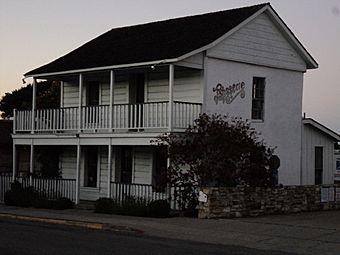
Fremont Adobe
|
|
| Location | Monterey, California |
|---|---|
| Area | 80.3 acres (32.5 ha) |
| Built | 1776 |
| Architect | Thomas O. Larkin |
| Architectural style | Colonial |
| NRHP reference No. | 70000137 |
Quick facts for kids Significant dates |
|
| Added to NRHP | April 15, 1970 |
| Designated NHLD | April 15, 1970 |
Monterey State Historic Park is a special place in Monterey, California. It's a state park that includes many old buildings. These buildings are part of the Monterey Old Town Historic District. This district was named a National Historic Landmark in 1970.
The park shows off California's history. It tells the story of how California changed. It went from being a Spanish outpost to a Mexican territory. Then, it became a U.S. state. You can see California's first theater here. You can also visit the Monterey Custom House. This is where the American flag was first raised over California.
The park has many restored historic buildings. These adobe houses were once part of California's first capital city. They were also where California's first constitution was written. Today, these buildings help us remember important parts of Spanish, Mexican, and American history in California. The park also has an Interpretive Center and the Pacific House Museum.
Contents
- Exploring Monterey's Historic Park
- The Custom House: Where California Joined the U.S.
- Cooper-Molera Adobe: A Blend of Styles
- Larkin House: The Monterey Colonial Style
- First Brick House: A New Way to Build
- Colton Hall: California's Constitution
- Old Whaling Station: A Look at the Past Economy
- First Theater: California's First Stage
- Stevenson House: A Famous Writer's Stay
- Pacific House Museum: Monterey's Capital Story
- Casa Soberanes: The House of the Blue Gate
- Casa del Oro: The House of Gold
- Sherman Quarters: A Future General's Home
- Doud House: An Early American Home
- See also
Exploring Monterey's Historic Park
The Custom House: Where California Joined the U.S.
The Custom House was built around 1821. The Mexican government built it. It is California's first historic landmark. It is also the oldest public building in the state. A very important event happened here. On July 7, 1846, the first American Flag was raised. This declared California a part of the United States. It is a National Historic Landmark and a California Historical Landmark.
Cooper-Molera Adobe: A Blend of Styles
The Cooper-Molera Adobe was built in 1823. A sailor named John B. R. Cooper built it. He became a rich merchant in Monterey. His daughter later married Eusebio Joseph Molera. This house mixes Spanish building styles with New England architecture. It's a great example of how different cultures influenced California. The property is now managed by the National Trust for Historic Preservation.
Larkin House: The Monterey Colonial Style
The Larkin House is also a National Historic Landmark. It combined Spanish building methods with New England designs. This mix created a new style. It was called the "Monterey Colonial" style. This style became very popular. The Larkin House is also a California Historical Landmark.
First Brick House: A New Way to Build
California's first brick house was built in 1847. Gallant Dickenson built it. He brought American building ideas to Monterey. Before this, people mostly used adobe blocks. Adobe walls had to be very thick. Brick walls could be thinner and stronger. Dickenson planned to make the house bigger. But he left for the California gold fields. The house later became a restaurant.
Colton Hall: California's Constitution
In 1849, a very important meeting happened here. The California constitution was written in this building. It was written in both English and Spanish. In 1850, California became the 31st state in America. Monterey was the capital for a while. But then San Jose became the capital. Today, people still act out the constitutional convention here. It happens every year during History Week. This building is a California Historical Landmark.
Old Whaling Station: A Look at the Past Economy
The Old Whaling Station was built in 1847. It was first a private home. But in 1855, it became a whaling company's office. It also housed the workers. This building supported the shore whaling business. A cool feature is its front walkway. It's made of whale bones! This building reminds us of Monterey's whaling history.
First Theater: California's First Stage
This adobe building is California's First Theater. An English sailor named Jack Swan built it. He built it in 1846–47. It was a place for sailors to stay and a tavern. In 1850, U.S. Army officers used it as a theater. They put on plays there. Swan made a small stage and provided benches. He used whale-oil lamps for light. Later, it was a lodging house for whalers.
The State of California bought it in 1906. For many years, a group called the Troupers of the Gold Coast performed plays there. Today, the building is closed to the public. But it opens for special events like "Christmas in the Adobes." This building is a California Historical Landmark.
Stevenson House: A Famous Writer's Stay
In 1879, a famous Scottish writer stayed here. His name was Robert Louis Stevenson. He wrote books like Strange Case of Dr Jekyll and Mr Hyde. He stayed at what was then the French Hotel. It's now called the Stevenson House. He was recovering his health during his travels. He was on his way to meet his future wife. Stevenson wrote articles for the local newspaper. The Stevenson House is a California Historical Landmark.
Pacific House Museum: Monterey's Capital Story
The Pacific House was built in 1847. This was during the U.S. occupation of California. The U.S. Army used this adobe building for many things. It was storage, a hotel, a court house, and a tavern. Later, it became offices. The gardens outside were once used for bullfights. Today, the Pacific House Museum tells Monterey's story. It shows when Monterey was the capital of Spanish and Mexican California. It also has the Monterey Museum of the American Indian. This building is a California Historical Landmark.
Casa Soberanes: The House of the Blue Gate
Rafael Estrada built Casa Soberanes in the 1840s. It's an adobe brick home on a hillside. His family lived there until 1860. Then the Soberanes family bought it. They lived there until 1922. Later, the Serranos restored the house. The house has old New England furniture. It also has Mexican folk art. It's nicknamed "The House of the Blue Gate." This is because of its blue garden gate. The garden paths are bordered with wine bottles and whale bones. This building is a California Historical Landmark.
Casa del Oro: The House of Gold
The Casa del Oro means "House of Gold" in Spanish. It's in the Custom House Plaza. It was built in 1849 as an army barracks. Then it was a hospital for sailors. Later, it became a general store. The name might come from a time when it was a saloon. It might also have been a place where miners exchanged gold dust. This building is a California Historical Landmark.
Sherman Quarters: A Future General's Home
The Sherman Quarters were built in 1834. Thomas Larkin built them. This small stone building was home to Lieutenant William Tecumseh Sherman in 1847. Sherman later became a famous general. He fought for the Union during the American Civil War. Later, an artist named Percy Gray lived there.
Doud House: An Early American Home
The Doud House was built in the late 1860s. Francis Doud and his family built it. It's one of the best examples of early American homes. These homes were built after the U.S. took over California. The house shows what wooden homes looked like back then. Its historical importance was recognized in 1917.
The gardens around the house are also special. They were named the Carmel Martin Memorial Garden in 1973. The Monterey History & Art Association now owns the property. They worked hard to restore it.
See also
- National Register of Historic Places listings in Monterey County, California
- List of the oldest buildings in the United States



